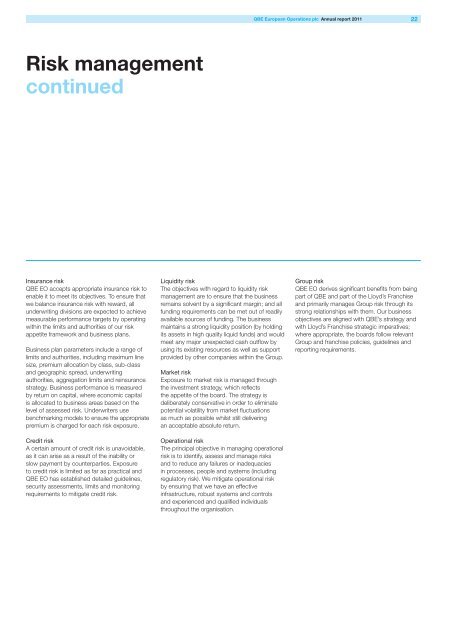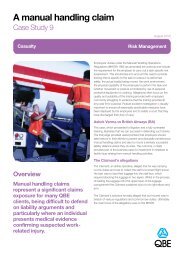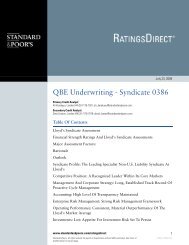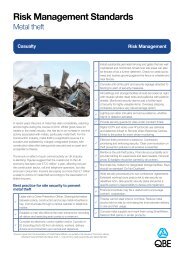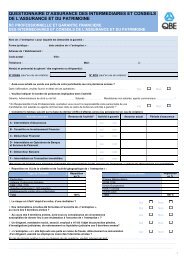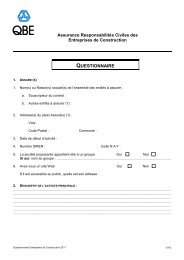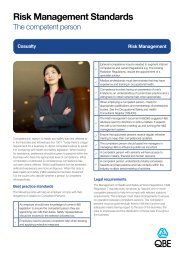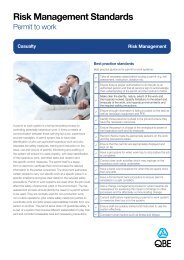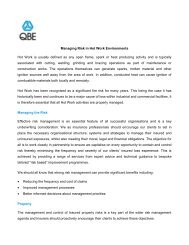QBE European Operations plc
QBE European Operations plc
QBE European Operations plc
You also want an ePaper? Increase the reach of your titles
YUMPU automatically turns print PDFs into web optimized ePapers that Google loves.
<strong>QBE</strong> <strong>European</strong> <strong>Operations</strong> <strong>plc</strong> Annual report 2011 22<br />
Risk management<br />
continued<br />
Insurance risk<br />
<strong>QBE</strong> EO accepts appropriate insurance risk to<br />
enable it to meet its objectives. To ensure that<br />
we balance insurance risk with reward, all<br />
underwriting divisions are expected to achieve<br />
measurable performance targets by operating<br />
within the limits and authorities of our risk<br />
appetite framework and business plans.<br />
Business plan parameters include a range of<br />
limits and authorities, including maximum line<br />
size, premium allocation by class, sub-class<br />
and geographic spread, underwriting<br />
authorities, aggregation limits and reinsurance<br />
strategy. Business performance is measured<br />
by return on capital, where economic capital<br />
is allocated to business areas based on the<br />
level of assessed risk. Underwriters use<br />
benchmarking models to ensure the appropriate<br />
premium is charged for each risk exposure.<br />
Credit risk<br />
A certain amount of credit risk is unavoidable,<br />
as it can arise as a result of the inability or<br />
slow payment by counterparties. Exposure<br />
to credit risk is limited as far as practical and<br />
<strong>QBE</strong> EO has established detailed guidelines,<br />
security assessments, limits and monitoring<br />
requirements to mitigate credit risk.<br />
Liquidity risk<br />
The objectives with regard to liquidity risk<br />
management are to ensure that the business<br />
remains solvent by a significant margin; and all<br />
funding requirements can be met out of readily<br />
available sources of funding. The business<br />
maintains a strong liquidity position (by holding<br />
its assets in high quality liquid funds) and would<br />
meet any major unexpected cash outflow by<br />
using its existing resources as well as support<br />
provided by other companies within the Group.<br />
Market risk<br />
Exposure to market risk is managed through<br />
the investment strategy, which reflects<br />
the appetite of the board. The strategy is<br />
deliberately conservative in order to eliminate<br />
potential volatility from market fluctuations<br />
as much as possible whilst still delivering<br />
an acceptable absolute return.<br />
Operational risk<br />
The principal objective in managing operational<br />
risk is to identify, assess and manage risks<br />
and to reduce any failures or inadequacies<br />
in processes, people and systems (including<br />
regulatory risk). We mitigate operational risk<br />
by ensuring that we have an effective<br />
infrastructure, robust systems and controls<br />
and experienced and qualified individuals<br />
throughout the organisation.<br />
Group risk<br />
<strong>QBE</strong> EO derives significant benefits from being<br />
part of <strong>QBE</strong> and part of the Lloyd’s Franchise<br />
and primarily manages Group risk through its<br />
strong relationships with them. Our business<br />
objectives are aligned with <strong>QBE</strong>’s strategy and<br />
with Lloyd’s Franchise strategic imperatives;<br />
where appropriate, the boards follow relevant<br />
Group and franchise policies, guidelines and<br />
reporting requirements.


